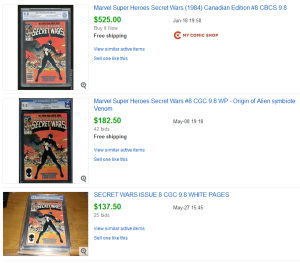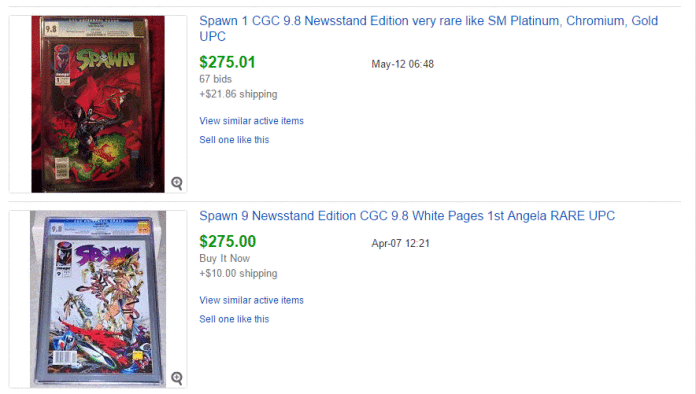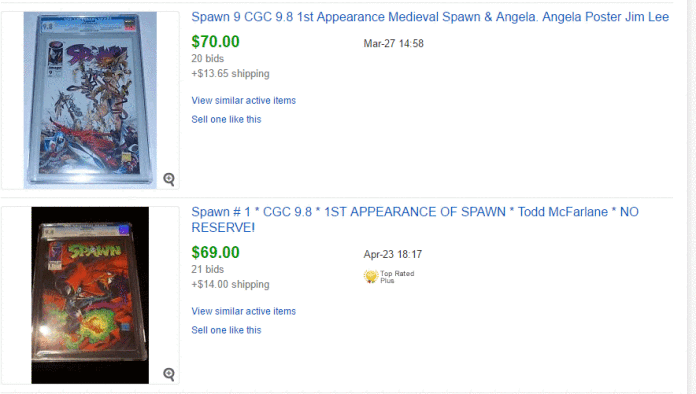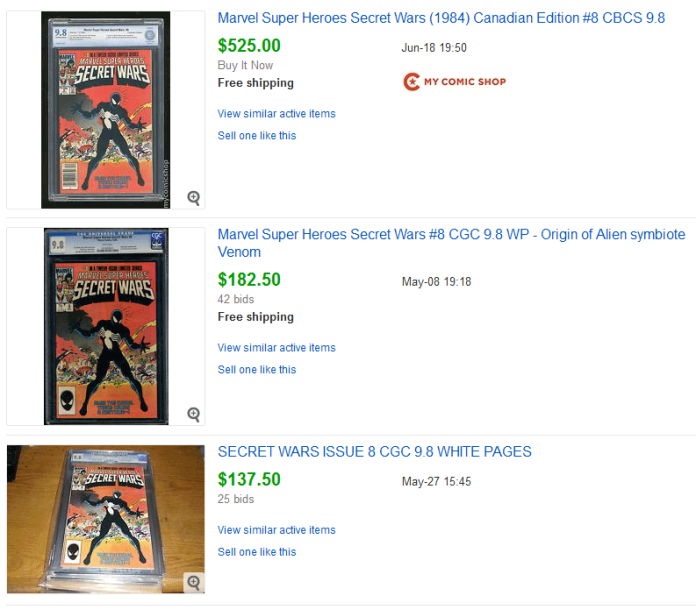By Benjamin Nobel, July 6, 2016

All of the above are 9.8’s but the Canadian Newsstand Edition (top) sold for a higher price than the two direct editions (middle and bottom) combined. After reading this post you will understand why!
In this post I will answer the commonly asked question: Why Are Newsstand Comics Worth More?
Newsstand comics aren’t always worth more, and aren’t always more rare — for example in the 1979-1980 time-frame the estimated percentage of comic book distribution that was newsstand was actually the vast bulk of it at ~94% (so for 1979 the question could very well be flipped: why are direct edition comics worth more? [And Marvel produced distinct non-returnable versions of its comics from 1977-1979 as well, often sold in Whitman multi-packs]). But that situation quickly changed: with the rise of specialty comic shops, direct edition sales quickly took over the market. We went from one extreme in June of 1979 when Marvel’s direct edition sales to comic shops under new ‘trade terms’ started, to the opposite extreme in 2013 when Marvel’s newsstand sales finally ended.
In 2013 — the year Marvel pulled the plug on its newsstand distribution channel entirely — Comichron’s published comic book sales estimates show just 6.8% newsstand ($25 million) versus direct edition at 93.2% ($340 million), across the industry for the year. We learned from an industry insider that their estimate of Marvel’s newsstand percentage had dwindled all the way down 1% by that 2013 endpoint. Marvel’s David Gabriel revealed that Marvel ended newsstand sales through Barnes & Noble and Books-A-Million bookstores in 2013, and also revealed that Marvel’s newsstand sales had ended to all other newsstand outlets two years prior to that — which would have been circa 2010-2011. So the wind-down was happening for quite some time before the very last Marvel newsstand comics were published in 2013.
Information about the percentages for other years have been discussed and debated out there as well. For example, Marvel’s 1999-era thinking about the newsstand distribution channel was revealed by Marvel VP Bill Jemas — newsstand sales were cited to be 14% when Jemas arrived in 1999, and he described how the company had made a decision to “walk away” from the newsstand:
“When Jemas arrived at Marvel in 1999, newsstand sales were at 14%, according to the BPA’s audits for the first half of the year, and the company made a conscious decision to walk away from the newsstand in favor of reprint collections in bookstores, owing to the serialized nature of the stories. “I have a pretty good imagination, but I can’t see a twelve-year-old going to a newsstand six months in a row to pick up the right Spider-Man comic to get a complete story. I can see a twelve-year-old going to a bookstore and picking up a book with the whole Spider-Man story in it,” is how Jemas explains the decision.”
— The Business Of Content
And then looking back further, we also have estimates out there for how the numbers looked in the 1980’s:
“Because I had such a personal vested interest in the growth trends of the Direct Market, during the early 1980’s I quizzed everyone at Marvel who would give me figures as to what impact comics shops were having on the sales at company. I derived the following estimated numbers specifically from conversations with Jim Shooter, Ed Shukin, Michael Hobson, and Carol Kalish:
1979 Direct Market 6% of Marvel’s gross sales
1982 Direct Market 20% of Marvel’s gross sales
1985 Direct Market 50% of Marvel’s gross sales
1987 Direct Market 70% of Marvel’s gross sales”— From “Modifications to the Distribution System“, Chuck Rozanski
There are a few particularly interesting observations we can make about the above, but one thing I want to point out is that the 1982 number was said to be a mere 20% direct edition and a full 80% newsstand — and yet, go look for high grade copies of key 1982 comics out there and if your experience matches mine you’ll find that the vast majority you find out there are actually direct edition copies, even with comics published in 1982 when the original distribution percentage was said to be just 20%! An example of this phenomenon can be seen hunting down high grade newsstand copies of Wolverine Limited Series #1 — if you go by the “observed rarity” of what is out there in the marketplace, you reach a completely different conclusion about what the rarity of surviving copies looks like. [Greg Holland has also done work on this topic, studying the observed eBay rarity by year of publication from 1980-1986, between the direct edition type and the newsstand type].
And we should pause on the word “surviving” because it is a critical component in comic book rarity separate and distinct from considering the original distribution percentage at sale — newsstand buyers as a generalization bought comics to read them, and did not preserve their condition the way shoppers at specialty comic shops preserved their copies (these shops got the “direct edition” copies, and they differed in being non-returnable [read more about the history here: Comic Book Newsstand Editions: Understanding The Difference]). There was also a difference in how the staff handled the comics, where newsstand staff treated them like magazines (with no training to preserve condition), while comic store staff meanwhile treated their direct edition copies as collectibles, often bagging and boarding them immediately and handling them with great care. So although the original distribution rarity paints one picture, factoring in how well preserved the direct edition copies were, we may be looking at a completely different picture when it comes to surviving copies in collectible-grade condition.
A collector might think at this point: let’s just check the CGC census and see what the surviving rarity difference looks like, between direct edition and newsstand copies, by counting up the number of each type that have been graded? But alas, CGC elected to “lump together” both versions by issue number… except for some special cases. And by studying some of these special cases we can see the survivorship numbers really start to stand out. One “class” of comic books to examine that really drives these numbers home are the ~2-7% of 1980’s-era comic books that are Canadian Price Variants (read this post about how to spot them)… because A) these were newsstand-only, and, B) they are one of the instances where CGC does “break them out” on the census — so we can get a count of how many have been graded! 🙂
And it turns out there are many “keys” that fall into the price variant window, with thousands of copies submitted, giving us great CGC census data we can look at (a huge sample size of data). For example in this post, I examined X-Factor #6 and found that although we might expect to see about 4% of copies show up on census as the newsstand-only 95-cent-variant based on estimation of the original percentage at time of sale, we actually see zero point four percent rarity showing up on the CGC census. This census rarity an order of magnitude different suggests to us that only 1 out of 10 copies originally distributed on the newsstands in Canada are showing up in today’s CGC census numbers.
Another factor to consider about newsstand distribution is that it was “spotty” and unreliable. As an example of this, see my post about how Marvel “cycled” the Amazing Spider-Man / Friendly Neighborhood Spider-Man / Sensational Spider-Man UPC codes on ASM newsstand copies, and depending on the code, certain issues never even made it to some newsstand outlets (while other issue numbers did). Jim Shooter has a great quote about the nature of newsstand distribution:
“The newsstand cast a wide net. It funneled wannabe collectors into the comics shops. In a way, the spotty, unreliable, inconsistent nature of newsstand distribution was a good thing, because someone who just had to have every issue was more or less forced to seek out a comics shop.”
— From “Comic Book Distribution Part Three,” Jim Shooter
So we can surmise that within the “broad” distribution percentage industry insiders have revealed to us, we may also have issue by issue variability that causes some specific comics to be harder to find in newsstand, versus others. It is also logical that the “major” titles would sell better on newsstands than the lesser-known titles — an example of this phenomenon that I noticed and pointed out in my post entitled 75 Cent Variants (Canadian Newsstand Editions) is how 75 cent copies of New Mutants #1 appear to be absent (currently) from the CGC census, even though I found them out there in the marketplace and pictured one in the post, so I know they do exist. We can draw a picture in our minds of a reader hooked on Amazing Spider-Man at their local newsstand — they might pick up a Secret Wars #8 too, but might just as well skip that other title and stick with the one they’d been reading. A reader hooked on Uncanny X-Men might pick up a New Mutants #1 but might just as well skip it… So the actual sell-through could vary widely by issue. And the sell-through was only a slice of the copies printed.
“While it was seldom that a newsstand sold more than 30% of the new comics they displayed (they were able to return unsold copies for full credit at the end of the month…), comics specialty stores were a guaranteed 100% sell-through, as they purchased on non-returnable basis. Freed from the enormous printing costs of publishing three comics for every one that sold, and also being able to eliminate the administration costs of issuing credits for returns, the publishers suddenly found themselves awash in profits.”
— From “Destroying the Entry Point of Most New Readers,” Chuck Rozanski
And with newsstand sales, as mentioned in the above quote, unsold copies were returnable to the publisher for refund. Here’s Jim Shooter on this subject:
“The reason unsold books were called returns is that, in ancient days, all unsold copies were returned to the publisher intact! Publishers were free to redistribute their publications to secondary or international markets, offer them through a back issue service, or sell them for pulp.”
— From “Comic Book Distribution,” Jim Shooter
So another variable is what the publisher did with the returns for any given issue. If they were pulped for a given issue, that would mean surviving newsstand copies would be more scarce, than if they were sold intact into a secondary market. And then the period in time also makes a difference… Returns weren’t always intact comic books:
“Things changed. The cost of shipping the returns back was a burden. Eventually, Independent Distributor Wholesalers (“ID’s”) were allowed to merely tear the covers off and return those as evidence of the number unsold. Of course, some ID’s would then sell some of the coverless books through various lower-tier or bargain outlets, or for paper pulp.”
— From “Comic Book Distribution,” Jim Shooter
So a given newsstand comic that arose out of the period where covers were torn off as evidence of unsold copies, would also see a drastically lower percentage of “high grade survivors” versus another issue that was returned intact and resold into another market.
Note too that there are many comic book issues that were “direct edition exclusives” — i.e. you could only find them in the comic shops, and they simply did not print any newsstand copies. So for these cases, the number of newsstand copies would be zero. An example of a Direct Edition exclusive was Dazzler #1:
“At the end of 1980, Marvel published the first regular comic book that was sold exclusively through the Direct Market, Dazzler #1. It sold 428,000 copies.”
“After that success, many more Direct-only offerings were published by Marvel and others. As the Direct Market boomed, increasingly it became the focus at Marvel. It was a low-margin business, yes, but it was firm sale, and it was pretty easy to target Direct Market consumers. We knew what they wanted. It was like shooting fish in a barrel.”
— From “Comic Book Distribution Part Three,” Jim Shooter
Exclusives such as this drew collectors away from the newsstands and into the comic shops, because these comics simply could not be bought on newsstands. So between the spotty, unreliable nature of newsstand distribution, the direct market exclusives, and the fact that “serious collectors” knew that newsstand comics were going to have suffered condition damage right off the bat (as soon as they hit those metal racks, all but the lucky “sandwiched” copies would have been likely to suffer bends and indentations immediately), collectors were flocking over to the specialty comic shops, where direct edition, not newsstand, comics were sold.
So it is easy to see why direct edition sales “took over” the market for comic books and became such an incredibly high percentage of the total distribution. This might lead collectors to wonder: why bother maintaining newsstand sales? If the higher cover price variants for newsstands in Canada were only an estimated 2-7% of the total, and if U.S. newsstand sales were down to single digit percentages by 2013, why even bother creating such a small number of copies in those cases? For one thing, no company wants to see a year-over-year sales decrease, even a small one, so it is hard to picture any executive “at the helm” of these publishers scoffing at even a small percentage of sales — erase those sales and they might not reach their year-over-year sales growth targets. Another factor was advertising. As Jim Shooter explained, it actually still made sense to distribute comics on newsstands if they were losing a little money on that distribution channel:
“Newsstand sales also raised our total circulation, which enabled us to charge more for advertising space in the books. Given the economies of scale and other benefits the newsstand provided, it made sense to remain in that market even if we were only breaking even there. Even if we were losing a little money!”
— From “Comic Book Distribution Part Three,” Jim Shooter
But maintaining newsstand sales and supporting newsstand sales are two completely different things. And Shooter makes it clear how the top executives felt about doing that:
“Kalish vehemently opposed a newsstand exclusive. She vehemently objected to any support of any kind for the newsstand. She claimed that the Direct Distributors and shop owners would see any such things as betrayal, rise up in anger and retaliate against Marvel. Why not just hand the Direct Market over to DC?”
“The Direct Market was easy money, quick money, sure money to the brass—not that any of them had ever set foot in a comics shop or even opened a comic book. To them it was about moving the units and collecting the cash. Might as well have been widgets we were selling. But, they knew the Direct Market was shooting fish in a barrel. Why jeopardize that?”
— From “Comic Book Distribution Part Three,” Jim Shooter
So with no “support” for the newsstand distribution channel in the cards, and direct edition sales so profitable, it is no wonder the distribution percentages changed over the years the way they did. Here is Chuck Rozanski again:
“With sales of comics melting away into the much more efficient Direct Market specialty stores, only the most dedicated newsstands chose to keep comics available after 1987.”
“If you consider that the expansion in market share by the Direct Market was paralleled by the simultaneous collapse of the newsstand business, it becomes clear that Marvel Comics would not have survived the 1980’s without the robust growth in comics specialty shops.”
— From “Modifications to the Distribution System,” Chuck Rozanski
So what does this all mean for newsstand comic values? Let’s go back to the original question I’m tackling here: Why Are Newsstand Comics Worth More?
The answer sitting here today in 2016 all depends on the direct edition vs. newsstand edition rarity numbers for the given comic, and, the answer is also what I’d call “developing” — because the knowledge of the relative rarity numbers in the collecting community are quite variable. Broadly speaking, the difference between newsstand vs. direct edition comics is not something most collectors think about today.
For most newsstand comics, they are “lumped together” by issue number both by CGC on their online census, and by price guides like Overstreet. So the difference is effectively hidden for all but those who have inquiring minds and start asking their own questions about the difference (and then learning the answers).
But remember how I mentioned about how certain newsstand comic books are broken out? On the CGC census, there are the 75 cent variants (Canadian newsstand editions) that are “broken out,” they also have decided to “break out” a class of cover price variants from the 2008-2010 era (“$3.99 Newsstand Edition” and “$4.99 Newsstand Edition” — look for future posts from me on that subject once I have some CGC submissions back and can share some pictures [8/31/16 update: here’s a post on these]). And then there are two other cases I’m aware of where CGC has decided they will “break out” newsstand comics on census: UPC code “errors” (where the comic is “mis-identified” as a different title), and manufacturing differences.
Here’s an example for that last category: Spawn #9 Newsstand Edition. As an example comic to examine the question of why newsstand comics are worth more, this one has everything we’d want in an example:
- The rarity is extreme (I’ll share a quote about that in a moment).
- CGC “breaks out” newsstand copies of this particular issue on census because of manufacturing differences.
- Thousands of copies have been sent to CGC because it is a “key” so there is a huge sample size of data.
First, the rarity: Image Comics as an upstart publisher in the 90’s (well past the point of direct edition comics “taking over” the market) was only able to sell 1% of their comic books on newsstands:
“Another consideration about newsstand editions is that different publishers produced them at different times. Image, for example, had a vigorous newsstand program right from the beginning, but still sold 99% of their comics through the Direct Market.”
— From “Newsstand Editions History,” Chuck Rozanski
Next, the manufacturing differences: among other things, Image chose to use cheap “newsprint” paper for the interior pages of newsstand copies of Spawn #9, versus “glossy” paper for direct edition copies.
Finally: the CGC census data. As a “key” issue, over a thousand copies have been turned in as of this writing (in fact, 1,511 as of this moment), and 2.5% of those show up as the Newsstand Edition. For some contrast, 35 cent cover price copies of Star Wars #1 show up on census with 3.2% rarity. (I don’t know about you, but I think that comparison is kind of mind-blowing!)
So… Is the market reflecting this rarity for Spawn #9 in sales prices? Are the newsstand editions of this example actually worth more? And the answer, actually, is yes. Newsstand edition copies of both Spawn #1 and Spawn #9 are selling for premiums to their prevalent direct edition counterparts, especially when we move up to the 9.8 grade tier:

Newsstand 9.8 Spawn #1 and #9 copies recently sold for prices upwards of $275.
As you can see, recent 9.8 newsstand copies of Spawn #1 and Spawn #9 are both recently selling for upwards of $275. Direct edition copies, however, are only selling for around $70 in the same grade:

Spawn #1 and #9 direct edition copies in 9.8 are worth a whole lot less, at around $70.
[More about this: Spawn Newsstand Values Pulling Away From Direct Edition]
But I can tell you first-hand that in 2013-2014, this was not the case… Newsstand 9.8 copies of Spawn #1 could still be won for $70-80 at auction. So the values of the more rare newsstand copies “pulling apart” from the prevalent direct edition copies in this way are actually a relatively recent phenomenon. And that’s why I said before that the answer to the question this post addresses is developing. Knowledge of newsstand rarity is still in the process of spreading. Search for information about newsstand comics and half of what you’ll find out there are collectors with a myopic focus on condition who do not know about the rarity numbers, and sharing about how they avoid newsstand comics as an “inferior” product!
But more collectors seem to be putting thought into newsstand comics as discussions take place and information makes its way around. It took a very long time for 35 cent variants to “get noticed” by collectors, and it has taken even longer for .75/.95/$1.00 Canadian variants to command a premium deserved by their rarity. For example, even just back in April of this year, 9.8 Canadian Edition copies of Secret Wars #8 ($1.00 variant cover price) were selling for equivalent prices to regular direct edition copies. Look where they are now:

Value for the Canadian newsstand edition with $1.00 cover price has “pulled away” from regular direct edition copies, for Secret Wars #8.
It is pretty clear to this collector that it is only a matter of time before newsstand comics are worth more than their direct edition counterparts even more widely than the specific examples where this can be observed today. The special cases where CGC “breaks out” newsstand comics as variants, such as Canadian Editions, $3.99 Newsstand Editions, Newsstand Variants, and Newsstand Editions, are particularly interesting to me [read more about those special situations here]. And I’ll end this post on that note with a Wayne Gretzky quote:
“I skate to where the puck is going to be, not to where it has been.” — Wayne Gretzky
Happy Collecting! 🙂
[Author’s note: see the following 2/3/2017 update post on the rolling snowball of growing newsstand awareness — “Nice book, too bad it’s a direct edition”]
